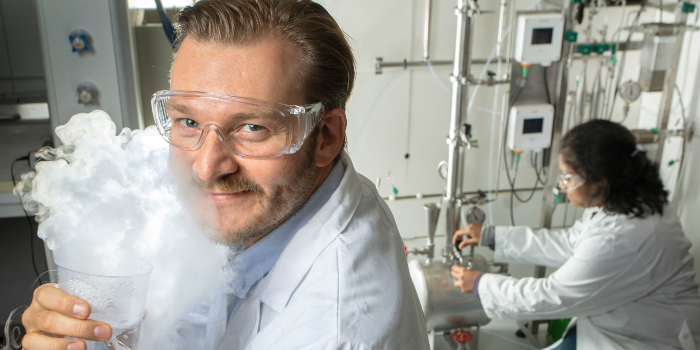CO2 must be captured – and exploited
Researchers will develop a mobile plant that can capture CO2 before it is released into the atmosphere and greenhouse gas will instead be exploited for new products

This winter, DTU researchers will begin building a mobile plant that can capture CO2. Initially, the plant will be tested at biogas plants, says Associate Professor Philip L. Fosbøl from DTU Chemical Engineering, who is coordinating the CO2 capturing process.
“Biogas is produced by fermenting biomass, and the gas consists primarily of the greenhouse gases methane and CO2. Biogas can be burned to produce heat, but you can also upgrade biogases to obtain methane—a more valuable product that can be exploited in the natural gas supply. In the upgrading process, the CO2 is separated from the biogas. Today, CO2 is considered a waste product that is disposed of through release into the environment. Instead, we’re examining how we can effectively capture and reuse it,” says Philip L. Fosbøl.
For many years, there has been a global interest in CO2 capture. This interest has reached new heights since the UN’s Intergovernmental Panel on Climate Change published its special 2018 ‘Global Warming of 1.5 °C’ with the message that CO2 capture is a must if the global community is to limit global warming to 1.5 degrees.
In the BioCO2 project, Philip L. Fosbøl has explored various ways to streamline the CO2 capturing process together with colleagues, students, and project partners (see fact box). Although they work with CO2 capture in the context of upgrading biogas, the technology is generic, so it can be implemented in principle in other companies or power plants looking to reduce their CO2 emissions.
CO2 captured using a liquid
When biogas is currently upgraded using standard methods, a considerable amount of CO2 is emitted—accounting for approximately 40 per cent of the biogas. With the new upgrade technology, CO2 emissions can be avoided. This is achieved by capturing the greenhouse gas. To capture it, it needs to be ‘scrubbed’. It is a process in which the CO2 is transported through long pipes and brought into contact with a liquid consisting of—among other things—the various additives that help the liquid to absorb the CO2. The additives may be different chemicals, but a joint research project between Novozymes and DTU Chemical Engineering is examining whether enzymes can help the CO2 to be absorbed by the liquid.
When this occurs, the CO2 is trapped and the researchers have already demonstrated this new and more effective way of capturing CO2 in small-scale experimental facilities. However, the ambitions do not stop here, as the researchers want to be able to recover the CO2 again in a cleaner form—i.e. without sulphur and other residues from the biogas. Clean CO2 can be considered a resource—a product that can be sold on and used for other purposes.
“Instead of seeing CO2 as an unwanted waste product, we can view it as a commodity. Today, CO2 is already being used for a wide range of purposes, including in soft drinks, welding, and other industrial processes. At DTU Chemical Engineering, we’re examining whether CO2 can also be used for the production of synthetic aviation fuel,” says Philip L. Fosbøl about the CO2, which can also be used in the food and pharmaceutical industry.
Reducing energy consumption
Capturing CO2 is just one part of the project which will also investigate whether the actual biogas upgrade can be done using much less energy.
“With our method, we have the potential to reduce energy consumption by up to 45 per cent compared to the standard process used today for upgrading biogas. However, we have to build our large plant before we can demonstrate whether we can achieve the major reduction,” says Philip L. Fosbøl, who expects the new plant, which is a scale model at 15 per cent the size of full scale, to be ready in spring 2020.
Capturing CO2 sounds simple, and according to Philip L. Fosbøl it is. And yet it is not a very widespread solution.
“It’s still cheaper for companies and power plants to release CO2 into the atmosphere than to invest in a plant that can capture it. But if you are able to not only capture it, but also recover it for resale, CO2 capture is no longer just an expense, but also a new way for companies and power plants to make money,” says Philip L. Fosbøl.
Source: DTU, press release, 2019-12-16.
